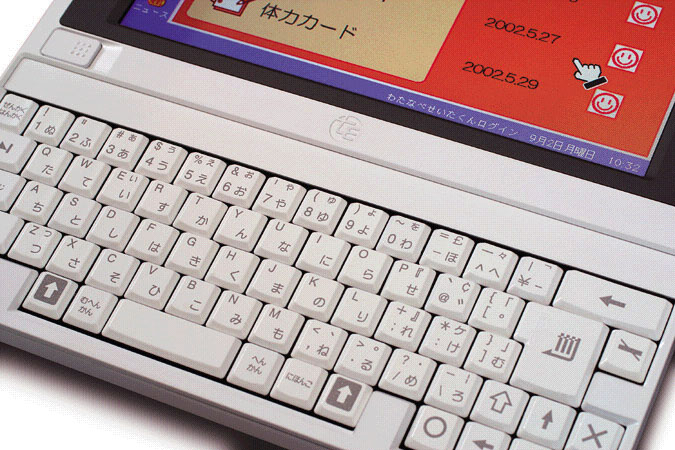

At the end of October 2002, PIN CHANGE Co., Ltd., a new company in the Matsushita group, made a surprise announcement about a new BTRON-based educational personal computer called "TEA Terminal," which it had developed in a short period of time (less than six months!) using the T-Engine development platform and available middleware. Even more surprisingly, the new educational computer, which is aimed at primary and middle schools, is the spitting image of Alan Kay's "Dynabook," which was conceived ages before Toshiba Corporation adopted the name for it's now famous laptop computer series. And it bears the T-Engine logo! Matsushita is back in the educational computer field with a futuristic computer and is proudly displaying T-Engine logo. Something really big seems to be going on behind the scenes. There seems to be a new pride in the accomplishments of the TRON Project, and forces seem to be coalescing behind it to drive it to new levels.
For those of you who weren't in Tokyo during 1988, Matsushita Electrical Industrial Co., Ltd., unveiled a very attractive BTRON-based personal computer for educational use called the PanaCAL ET, which was actually a dual OS machine that could also run MS-DOS. Although only a 16-bit machine, it could handle video, which shocked American engineers who saw it. It also shocked people who believed that desktop operating systems should be an American monopoly, and so the Office of the United States Trade Representative launched an attack on it after Japan's Center for Educational Computing decided it should be adopted for use in Japanese middle schools. Since Japan's economy was doing pretty well at the time, and Japan's leaders thought it would do well far into the future, they gave into U.S. government pressure, which adversely affected the BTRON subproject for well over a decade. It also adversely affected the TRON VLSI CPU subproject.
As a result of PIN CHANGE's announcement, already there are people who believe we are headed for another Japan-U.S. confrontation on trade. But this is difficult to believe. The biggest challenge to U.S. supremacy in desktop operating systems comes from right within its own borders in the form of the open source movement's GNU/Linux project, which is based on the hated--well, by Bill Gates, anyway--General Public License. Moreover, as a result of the discovery of hidden interfaces seemingly belonging to the U.S. National Security Agency in MS Windows, countries such as France and Germany are moving away from this operating system for government use. That's going to cost Bill Gates big bucks, big time--more than he could make by controlling low-cost educational computers in Japanese primary and middle schools. So the things that are really going to decide the fate of PIN CHANGE's new educational computer are ease-of-use and quality education software.
There is, of course, an excellent opportunity here for an American or European software firm to enter the Japanese educational software market, particularly one that has experience in developing programming languages for children. But very few foreign firms are interested in developing products tailored to the Japanese market. Foreign firms and governments are still trying to push western standards and business practices onto Japan, which indicates they haven't learned much from the past. The Japanese, on the only hand, seem to have learned from their mistakes in the past. There is no official standard for educational computers any more, so Japanese schools are free to adopt or reject PIN CHANGE's BTRON-based machine. It is probably for that reason that PIN CHANGE is planning a model for office/home use, also. In other words, the success of their new computer will not depend entirely on demand in the educational market, which was the case with the PanaCAL ET.
The biggest change compared to 1988, though, is that the Japanese have finally gotten the courage to brand their TRON-based products. It's about time. TRON is the most wide used operating system in the world. And as a result of T-Engine, TRON is going to become even more widely used. Look at the T-Engine logo below. Doesn't it look beautiful?
